
Detroit is the largest and most populous city in the U.S. state of Michigan, the largest U.S. city on the United States–Canada border, and the county seat of Wayne County. The municipality of Detroit had a population of 639,111 at the 2020 census, making it the 27th-most populous city in the United States. The metropolitan area, known as Metro Detroit, is home to 4.3 million people, making it the second-largest in the Midwest after the Chicago metropolitan area, and 14th-largest in the United States. Regarded as a major cultural center, Detroit is known for its contributions to music and as a repository for art, architecture and design, along with its historical automotive background.

Dearborn is a city in Wayne County in the U.S. state of Michigan. As of the 2020 census, it had a population of 109,976. Dearborn is the seventh most-populated city in Michigan and is home to the largest Muslim population in the United States per capita.

The Archdiocese of Detroit is a Latin Church ecclesiastical territory or archdiocese of the Catholic Church covering the Michigan counties of Lapeer, Macomb, Monroe, Oakland, St. Clair, and Wayne. It is the metropolitan archdiocese of the Ecclesiastical Province of Detroit, which includes all dioceses in the state of Michigan. In addition, in 2000 the archdiocese accepted pastoral responsibility for the Catholic Church in the Cayman Islands, which consists of Saint Ignatius Parish on Grand Cayman.
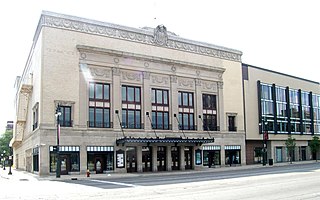
Orchestra Hall is an elaborate concert hall in the United States, located at 3711 Woodward Avenue in Midtown Detroit, Michigan. The hall is renowned for its superior acoustic properties and serves as the home of the internationally known Detroit Symphony Orchestra (DSO), the fourth oldest orchestra in the United States. With the creation of an adjoining auditorium for jazz and chamber music in 2003, Orchestra Hall became part of the Max M. and Marjorie S. Fisher Music Center. It was listed on the National Register of Historic Places in 1971.

Grosse Pointe refers to an affluent coastal area adjacent to Detroit, Michigan, United States, that comprises five adjacent individual cities. From southwest to northeast, they are:
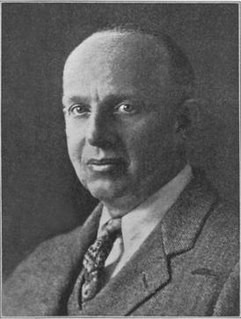
Wirt Clinton Rowland was an American architect best known for his work in Detroit, Michigan.
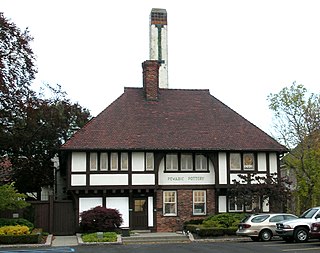
Pewabic Pottery is a ceramic studio and school at 10125 East Jefferson Avenue, Detroit, Michigan. Founded in 1903, the studio is known for its iridescent glazes, some of which grace notable buildings such as the Shedd Aquarium and Basilica of the National Shrine of the Immaculate Conception. The pottery continues in operation today, and was designated a National Historic Landmark in 1991.

The Detroit Opera House is an ornate opera house located at 1526 Broadway Street in Downtown Detroit, Michigan, within the Grand Circus Park Historic District. The 2,700-seat venue is the home of productions of the Michigan Opera Theatre and a variety of other events. The theatre was originally designed by C. Howard Crane, who created other prominent theatres in Detroit including The Fillmore Detroit, the Fox Theater and the Detroit Symphony's Orchestra Hall. It opened on January 22, 1922.

Southeast Michigan, also called southeastern Michigan, is a region in the Lower Peninsula of Michigan that is home to a majority of the state's businesses and industries as well as slightly over half of the state's population, most of whom are concentrated in Metro Detroit.
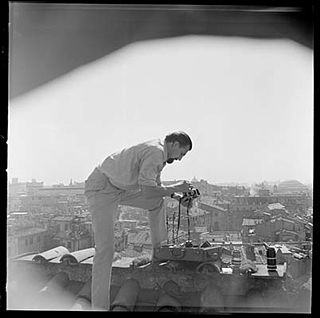
Balthazar Korab was a Hungarian-American photographer based in Detroit, Michigan specializing in architectural, art and landscape photography.
Naomi Long Madgett was an American poet and publisher. Originally a teacher, she later found fame with her award-winning poems and was also the founder and senior editor of Lotus Press, established in 1972, a publisher of poetry books by black poets. Known as "the godmother of African-American poetry", she was the Detroit poet laureate since 2001.

The Wayne County Building is a monumental government structure located at 600 Randolph Street in Downtown Detroit, Michigan. It formerly contained the Wayne County administrative offices – now located in the Guardian Building at 500 Griswold Street – and its courthouse. As Wayne County Courthouse, it was listed on the National Register of Historic Places in 1975. When it was completed in 1902, it was regarded as "one of the most sumptuous buildings in Michigan".
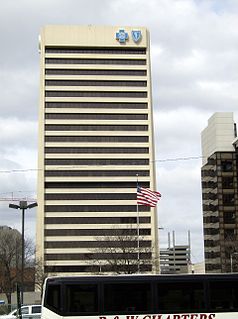
The Blue Cross Blue Shield of Michigan Building is a skyscraper located at 600 East Lafayette Boulevard in Downtown Detroit, Michigan, near the Renaissance Center complex. It is also known as the Blue Cross Blue Shield Service Center. It was constructed in 1971, and stands at 22 floors. The building was constructed in a sunken plaza. It houses Blue Cross Blue Shield of Michigan. The campus in downtown Detroit also includes offices for 3,000 employees at Towers 500 and 600 of the Renaissance Center linked by the Detroit People Mover.

The architecture of metropolitan Detroit continues to attract the attention of architects and preservationists alike. With one of the world's recognizable skylines, Detroit's waterfront panorama shows a variety of architectural styles. The post-modern neogothic spires of One Detroit Center refer to designs of the city's historic Art Deco skyscrapers. Together with the Renaissance Center, they form the city's distinctive skyline.
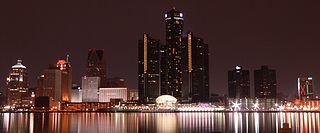
The metropolitan area surrounding and including Detroit, Michigan, is a ten-county area with a population of over 5.9 million, a workforce of 2.6 million, and about 347,000 businesses. Detroit's six-county Metropolitan Statistical Area has a population of about 4.3 million, a workforce of about 2.1 million, and a gross metropolitan product of $200.9 billion. Detroit's urban area has a population of 3.9 million. A 2005 PricewaterhouseCoopers study estimated that Detroit's urban area had a gross domestic product of $203 billion.

The Cultural Center Historic District is a historic district located in Midtown Detroit, Michigan, which includes the Art Center : the Detroit Public Library, the Detroit Institute of Arts, and the Horace H. Rackham Education Memorial Building were listed on the National Register of Historic Places in 1983. The district contains several cultural attractions.
Mary Virginia Beck was a Detroit Democratic Party politician, female activist and journalist from Pennsylvania, most notable for being Detroit's first female city council woman. She was also the first Ukrainian-American of Lemko descent to serve in that capacity. In 1957 she was also elected as the president of the city council. As a member of the council, Mary served for two decades from 1950 to 1970. In 1958-62 she also served as an acting mayor of Detroit city. During that period the Michigan scandalous politician Louis Miriani was the Mayor of Detroit (1957-1962).
The performing arts in Detroit include orchestra, live music, and theater, with more than a dozen performing arts venues. The stages and old time film palaces are generally located along Woodward Avenue, the city's central thoroughfare, in the Downtown, Midtown, and New Center areas. Some additional venues are located in neighborhood areas of the city. Many of the city's significant historic theaters have been revitalized.














